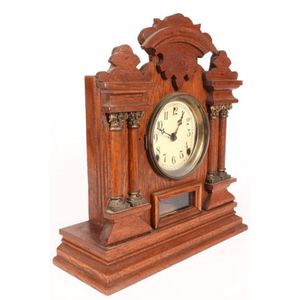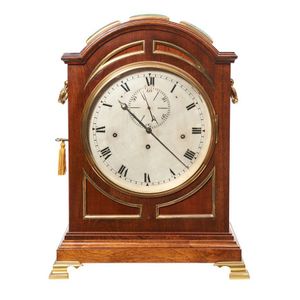Louis Philippe Mantel Clock
You must be a subscriber, and be logged in to view price and dealer details.
Subscribe Now to view actual auction price for this item
When you subscribe, you have the option of setting the currency in which to display prices to $Au, $US, $NZ or Stg.
- Ebony - Ebony is a close grained timber, black in colour. It has a fine texture which can be polished to a high gloss, making it suitable for venereering, inlay and stringing and its use as solid timber is resticted to small decorative items and ornamental decoration, such as chess pieces and musical instrument parts. The term "ebonised" means "faux ebony", timber that has been darkened during the polishing process to resemble ebony.
- Finial - An architectural decoration, found on the upper parts of of an object. On furniture they are usually found on pediments, canopies and shelf supports. On smaller ceramic or silver items, such as spoons, they may decorate the top of the item itself, or the lid or cover where they provide a useful handle for removal.
Finials have a variety of shapes and forms. They may be urn-shaped, baluster shaped round or spiral, but usually taper into an upper point. Many real life shapes may also be used as finials, such as pineapples, berries, pinecones, buds, lotus and acorns. Sometimes animals such as a lion are depicted, or fish and dolphins. - Movement - The technical name for the workings of a clock or watch, and does not include the dial or case.
- Maple - Maple, native to North America, is a dense heavy timber from light to yellow-brown in colour. It has very little distincive graining unless it is one of the variants such as birds-eye maple or burr maple, so was not used extensively for furniture in 18th and 19th century, where cabinetmakers and designers preferred timbers with more distinctive features such as mahogany, walnut, rosewood and oak.
Birds-eye maple has a seres of small spots linked by undulating lines in the grain, is highly sough and is used as a decorative veneer. Burr maple has larger and irregular grain swirls than birds-eye maple.
This item has been included into following indexes:
Visually similar items

Regency mahogany bracket clock white dial with Roman numerals, lion ring handles and glazed side panels and back door, moulded brass fee, two fusee movement unsigned and untested, height 50 cm

American Sessions mantle clock set with a circular dial, with Arabic numerals, set within a oak case, with architectural columns, on stepped pedestal base, height 40 cm

A George III table regulator clock, circa 1810, the break arch case with three brass trimmed rectangular glass panels set into the top of the arch. Circular cast brass bezel with brass inset panels above the dial and two brass inset panels below dial. Bras

American walnut late 19th century wall clock with pendulum, weights & winder length 107 cm
